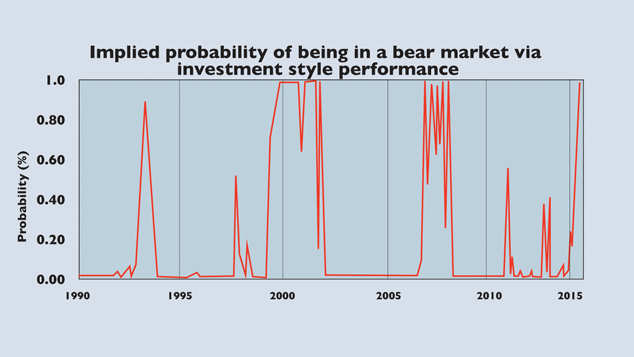Are we in a bear market?
Are the recent stockmarket falls part of something much bigger? Cris Sholto Heaton explains why predicting bear markets is a difficult science to conquer.


Ever since the recent sell-off in global stockmarkets got under way, one of the most frequent questions MoneyWeek has received is whether we're now in a bear market. What readers typically mean by this is not whether the market is going to go down by 20% or more the arbitrary figure that some investors use to distinguish a bear market from a correction (a fall of 10% or more).
Instead, they want to know if there's a reliable way to tell whether this is a short-lived drop that offers a good buying opportunity, or whether we're seeing the end of the six-year bull market and the shift to a very different kind of investment climate with much less potential for gains.
Unfortunately, this is a very difficult question to answer. To see why, let's turn to some research from Andrew Lapthorne and the equity quantitative research team at Societe Generale (SG). Earlier this year, they put out a note in which they attempted to design a model to predict the end of the bull market in the US ("a foolish exercise that we admit is more likely to lay us open to ridicule", as they knowingly put it).
Subscribe to MoneyWeek
Subscribe to MoneyWeek today and get your first six magazine issues absolutely FREE

Sign up to Money Morning
Don't miss the latest investment and personal finances news, market analysis, plus money-saving tips with our free twice-daily newsletter
Don't miss the latest investment and personal finances news, market analysis, plus money-saving tips with our free twice-daily newsletter
They tested a number of different approaches, including one that took into account the performance of different investment styles (for example, higher-quality stocks typically have much higher returns than lower-quality ones during a bear market). At the time, this model indicated that the likelihood that US stocks were in a bear market was low. But after the recent slump, the model suggests that a bear market has arrived (see chart). Given that it has a good record in identifying the last two bear markets (2000-2002 and 2007-2009), that may look a clear signal to bail out.
The dangers of predictions
However, these types of predictions are often not very reliable, as many egg-faced forecasters can testify. Economies and markets are complex, while shifts from bull to bear markets are comparatively infrequent events.
With the benefit of hindsight, it's usually possible to find plenty of indicators that coincided with past bear markets but that doesn't mean that they will prove to be a useful warning signal in future. Relationships may change. Worse, they may be purely coincidental all along: there is a well-known paper from 1995 that deliberately set out to demonstrate the dangers of spurious correlations by showing that the single economic variable that best "predicted" the performance of the S&P 500 from 1983 to 1993 was butter production in Bangladesh.
And indeed, the SG analysts' research offers an example of how a model that worked in hindsight doesn't necessarily help predict the future. One of their other models, based on macroeconomic data, also identified the last two bear markets. But it says that the odds of a bear market now are very low. So you have two models, built by the same analysts, both based on plausible data (no dairy products involved), both with a good fit to history, and both giving different answers. Which will prove correct remains to be seen but either way, it shows why forecasting bear markets is difficult and why making predictions is often a losing game.
Bear avoidance strategies
The question of whether it's possible to invest in a way that reduces the chance of being caught in a bear market is a slightly different one to whether it's possible to predict when bear markets will happen. Instead of trying to spot a bear market in advance and adjust your portfolio accordingly, you could try following a set of rules that would take you out of the market anytime that certain conditions are met even though this will result in lots of false positives (times when you're in cash even though a bear market doesn't happen). In other words, rather than trying to forecast a relatively rare event, you're looking for an approach that has added value on average over time.
But is this any easier? In a recent blog post, Mebane Faber of Cambria Asset Management suggests a simple market-timing rule for the S&P 500, which used value and price momentum: move into ten-year Treasury bonds if the market's cyclically adjusted price/earnings (Cape) ratio is over 16 or if the index is below its ten-month moving average. His calculations show
Get the latest financial news, insights and expert analysis from our award-winning MoneyWeek team, to help you understand what really matters when it comes to your finances.
Cris Sholto Heaton is an investment analyst and writer who has been contributing to MoneyWeek since 2006 and was managing editor of the magazine between 2016 and 2018. He is especially interested in international investing, believing many investors still focus too much on their home markets and that it pays to take advantage of all the opportunities the world offers. He often writes about Asian equities, international income and global asset allocation.
Cris began his career in financial services consultancy at PwC and Lane Clark & Peacock, before an abrupt change of direction into oil, gas and energy at Petroleum Economist and Platts and subsequently into investment research and writing. In addition to his articles for MoneyWeek, he also works with a number of asset managers, consultancies and financial information providers.
He holds the Chartered Financial Analyst designation and the Investment Management Certificate, as well as degrees in finance and mathematics. He has also studied acting, film-making and photography, and strongly suspects that an awareness of what makes a compelling story is just as important for understanding markets as any amount of qualifications.
-
 Review: Eden Roc Cap Cana – fun, sun and golf in the Caribbean
Review: Eden Roc Cap Cana – fun, sun and golf in the CaribbeanTravel Eden Roc Cap Cana in the Dominican Republic offers everything from relaxing by the pool to a world-class golf course
-
 Reeves delays cash ISA reform, but savers are not out of the woods yet
Reeves delays cash ISA reform, but savers are not out of the woods yetThe chancellor has reportedly delayed plans to cut the cash ISA limit, which were set to be announced at Mansion House on 15 July, and will take more time to consult with the industry
